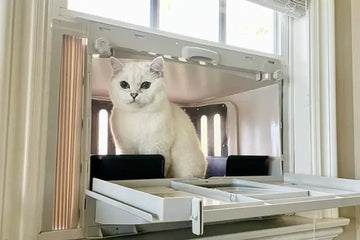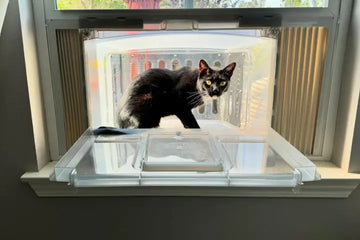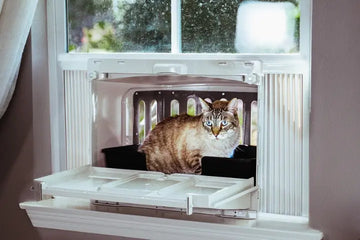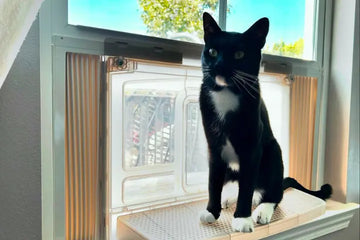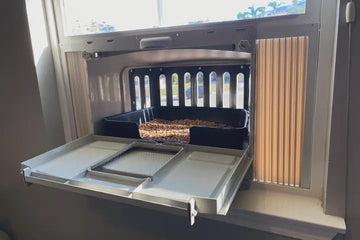Introducing a raised cat litter box to your home can significantly benefit both you and your feline friend. These types of boxes can help reduce the mess often associated with traditional litter boxes, as their elevated design minimizes litter spillage. Moreover, for cat owners, a raised kitty litter box offers easier access for cleaning, reducing the need to bend down too far, which can be particularly beneficial for elderly or mobility-impaired individuals.


Switching to a Raised Litter Box
Choosing the Right Box
Selecting the ideal raised litter box involves considering several key factors. The size of the box should comfortably accommodate your cat, allowing it to turn around and squat without any constraints. The height of the box is also crucial; it should be easily accessible to your cat while still providing the benefits of a raised design. Additionally, look for boxes with sturdy construction to prevent tipping or wobbling, which can deter your cat from using them.
Placement and Location
The location of the window cat litter box plays a significant role in its acceptance. Cats naturally seek out private, quiet spots for elimination, which helps them feel protected from predators, a behavior rooted in their instincts. A window location can provide an ideal balance by offering a view, that can be stimulating and enjoyable for your cat, while still meeting their need for a safe space. Choose a window that is less frequented by household members and away from bustling household activity. This not only reduces the chances of startling your cat but also minimizes the stress associated with high-traffic areas. Ensure that the chosen window does not face busy streets or loud external noises, as these can be significant deterrents for sensitive cats.
Ensure that the window area provides adequate ventilation to keep the area fresh but avoid direct drafts as extreme temperatures or strong winds can discourage your cat from using the litter box. The amount of sunlight coming through the window should also be considered. While some cats may appreciate a warm, sunny spot, others might find it overwhelmingly hot, especially in summer months, so adjustable shades or blinds can be beneficial.
Preparing the Area for Transition
Before introducing your cat to the new raised kitty litter box, make the area welcoming and appealing. Clean the space thoroughly to eliminate any odors or residues from previous items that might confuse your cat. You can place familiar items like toys or bedding near the box to create a positive association. Also, ensure the path to the litter box is clear of obstacles, making it easy for your cat to access.
Training a Cat to Use a Raised Litter Box
Placing the New Box Next to the Old Box
Positioning it adjacent to the existing one is a strategic and effective approach. This method leverages your cat's natural curiosity and comfort with familiar spaces, allowing a gradual and stress-free introduction to the new setup. By placing the new box right beside the old one, you create an environment where the new element becomes a part of your cat's known territory without abrupt changes. This proximity can significantly reduce any hesitance or anxiety associated with new objects. Over time, as your cat investigates and becomes accustomed to the presence of the raised box, it may begin using it voluntarily.
Using Familiar Scents to Encourage Use
Cats are highly scent-oriented creatures, using their keen sense of smell to interpret and navigate their surroundings. When introducing a new raised litter box, incorporating familiar scents can be a powerful motivator for your cat. By transferring some of the litter from the old box to the new one, you embed a sense of continuity and familiarity within the new environment. Rubbing a soft cloth that has your cat’s scent on it around the new box can further reassure your pet.
Reducing the Cleanliness of the Old Box
Encouraging your cat to transition to a new raised litter box can sometimes require making the old box less attractive. One effective way to do this is by gradually decreasing the frequency of cleaning the existing litter box. As the cleanliness of the old box diminishes, it becomes less inviting due to the buildup of odors and waste, which most cats find undesirable. This shift in the hygiene level will naturally propel your cat to seek a cleaner and more pleasant alternative, which will be the new, meticulously maintained litter box placed nearby. By manipulating the conditions of the old box to become progressively more unappealing, you subtly guide your cat’s preference toward the new option.
Monitoring Your Cat’s Behavior
Closely monitor your cat's behavior to measure how well the transition is progressing. Watch for signs of acceptance such as regular use of the new box or curious sniffing and exploring around it. Conversely, signs of distress or avoidance can indicate discomfort with the change. Here's a list to guide you:
-
Acceptance Signs:
- Regular use of the new box: If your cat consistently uses the lifted litter box, it's a clear indication they have accepted the change. This regular usage suggests they feel secure and comfortable with the height and location of the box.
- Curious behavior and sniffing around the new box: Initial curiosity such as sniffing and exploring around the box is a positive sign. It shows that your cat is interested and potentially accepting of the new arrangement.
- Comfortable body language while using the new box: Look for signs of relaxed posture and ease when your cat uses the litter box. Comfortable body language, such as a relaxed tail and ears, indicates that they feel safe and at ease with the new litter box setup.
-
Distress or Avoidance Signs:
- Ignoring or avoiding the new box: If your cat avoids the new litter box or completely ignores it, it might suggest discomfort or disapproval of the new setup. This avoidance behavior can be a critical sign that the location, height, or style of the box does not meet your cat's preferences or needs.
- Signs of stress when near the new box, such as hissing or backing away: Demonstrations of stress, including hissing, backing away, or other fearful behaviors when approaching the litter box, are urgent signs of distress. Such reactions imply that the newly lifted box may be intimidating or unsuitable for your cat.
After identifying these signs, it's essential to adjust the environment accordingly. If your cat shows signs of acceptance, continue monitoring but feel reassured that they are adapting well. On the other hand, if there are signs of distress or avoidance, consider alternative solutions such as changing the box's location, lowering its height, or gradually acclimating your cat to the new setup. These adjustments can make a significant difference in how your cat interacts with their litter box, ensuring their comfort and happiness in their daily routine.
Positive Reinforcement Techniques
Rewarding Your Cat
Positive reinforcement is an effective method to encourage your cat during the transition to a raised litter box. Whenever your cat uses the new box, immediately offer a reward. This could be in the form of extra petting or verbal praise. These rewards help your cat associate the use of the new box with positive outcomes, thereby increasing the likelihood of repeated use.
Using Treats
Cats are particularly responsive to treats immediately following the desired action. Pair the treat with enthusiastic praise in a cheerful tone to enhance the positive association. Over time, you can gradually reduce the treats and rely more on praise as your cat becomes accustomed to using the window litter box.
Handling Hesitancy and Resistance
If your cat shows hesitancy or resistance to the new raised kitty litter box, it's important to remain patient and understanding. Avoid any negative reinforcement that could create fear or anxiety. Instead, try to identify and mitigate the factors contributing to your cat's reluctance. This might involve adjusting the box's height, location, or even the type of litter used to find a combination that your cat is comfortable with.
Aiding Accessibility for Elderly and Mobility-Impaired Cats
Lower Entry Points or Adjustable Heights
For elderly and mobility-impaired cats, the design of the raised litter box is crucial. Select models that feature lower entry points or adjustable heights to accommodate your cat's physical capabilities. This consideration ensures that the box is accessible to cats who may have trouble jumping or climbing due to arthritis or other mobility issues.
Using Ramps or Steps
Incorporating ramps or steps can greatly enhance accessibility for cats with limited mobility. These aids help cats enter and exit the litter box with ease, reducing the risk of injury and discomfort. Ensure that these accessories are stable and have a non-slip surface to provide a secure footing for your cat.
Comfort Considerations
Beyond accessibility, comfort is vital for mobility-impaired cats. The interior of the lifted litter box should be spacious enough to allow your cat to maneuver comfortably without feeling cramped. The choice of litter is also a significant factor in the comfort of mobility-impaired cats. Traditional clay litters can be rough on delicate paws, especially for cats with joint problems or declawed cats. Biodegradable litter, such as those made from recycled paper, wood pellets, or walnut shells, are softer and may provide a more comfortable surface. These materials are not only gentle on paws but also tend to be lighter, making it easier for cats to dig and cover their waste without straining. Moreover, the dust-free nature of many biodegradable litters can be beneficial for cats with respiratory issues, reducing the risk of irritation when they are covering their waste or simply moving around in their box. Every detail that enhances comfort can help your cat adapt more quickly and continue to use the best litter boxes for the elderly.


Troubleshooting Common Issues
Solutions for Space Constraints
Space constraints can pose challenges when introducing a new window cat litter box. If space is limited, focus on optimizing the existing area. This might involve reorganizing furniture or decluttering to make room for the litter box. Ensuring that the box is not crammed into a tight space or an uncomfortable corner is essential, as cats need a welcoming and accessible area to adapt to changes in their toileting environment.
Calm and Comfortable Environment
Minimize loud noises, sudden movements, and other disruptions that could stress your cat. Regarding the overall ambiance of the area around the new litter box — a calming, quiet space can make a significant difference in how quickly and smoothly your cat adjusts to the new setup.
Long-Term Maintenance and Care
Regular Cleaning and Hygiene Practices
Maintaining a raised litter box effectively is essential for ensuring a healthy environment for your cat and keeping your home odor-free and pleasant. Adopting a structured cleaning routine can make a significant difference. Here’s a guide to help you keep the litter box in excellent condition:
- Daily Maintenance: Regular daily maintenance of the litter box is crucial to prevent odors and maintain hygiene. Each day, make it a routine to scoop out any waste. This not only helps in controlling odor but also makes the litter box more appealing to your cat, encouraging regular use. Keeping the litter fresh and clean daily minimizes the risk of bacterial growth and maintains a sanitary environment for both your cat and your household.
- Weekly Cleaning: Comprehensive weekly cleaning of the raised litter box is essential to ensure a completely clean and odor-free environment. This should involve removing all the old litter, scrubbing the box with a mild, non-toxic cleaner to remove lingering odors and residues, and then replacing it with fresh litter. Using non-toxic cleaners is important to avoid any irritation to your cat’s sensitive paws and nose. Regularly washing the litter box also prevents the buildup of harmful bacteria and keeps the litter box environment healthy and inviting for your pet.
Implementing these maintenance practices will not only provide your cat with a clean and comfortable space but will also contribute to the overall cleanliness and aroma of your home. By ensuring these tasks are done regularly, you can create a pleasant living space for everyone in the household, while also catering to your cat’s needs.


Observing Cat’s Health and Behavior
Changes in the litter box for elderly people's usage can often signal health issues, such as urinary tract infections or mobility problems. If you notice any sudden changes in your cat’s litter box habits, it’s advisable to consult with a veterinarian to rule out potential health concerns.
As you implement these raised litter box training, sharing your experiences can be incredibly valuable both for you and for the broader pet owner community. Whether through online forums, social media, or direct conversations, discussing what worked and what didn’t can help others in their journey toward a transition cat to a raised litter box. Likewise, feedback from others can provide you with insights and ideas to refine your approach, ensuring ongoing success and well-being for your feline friend.



